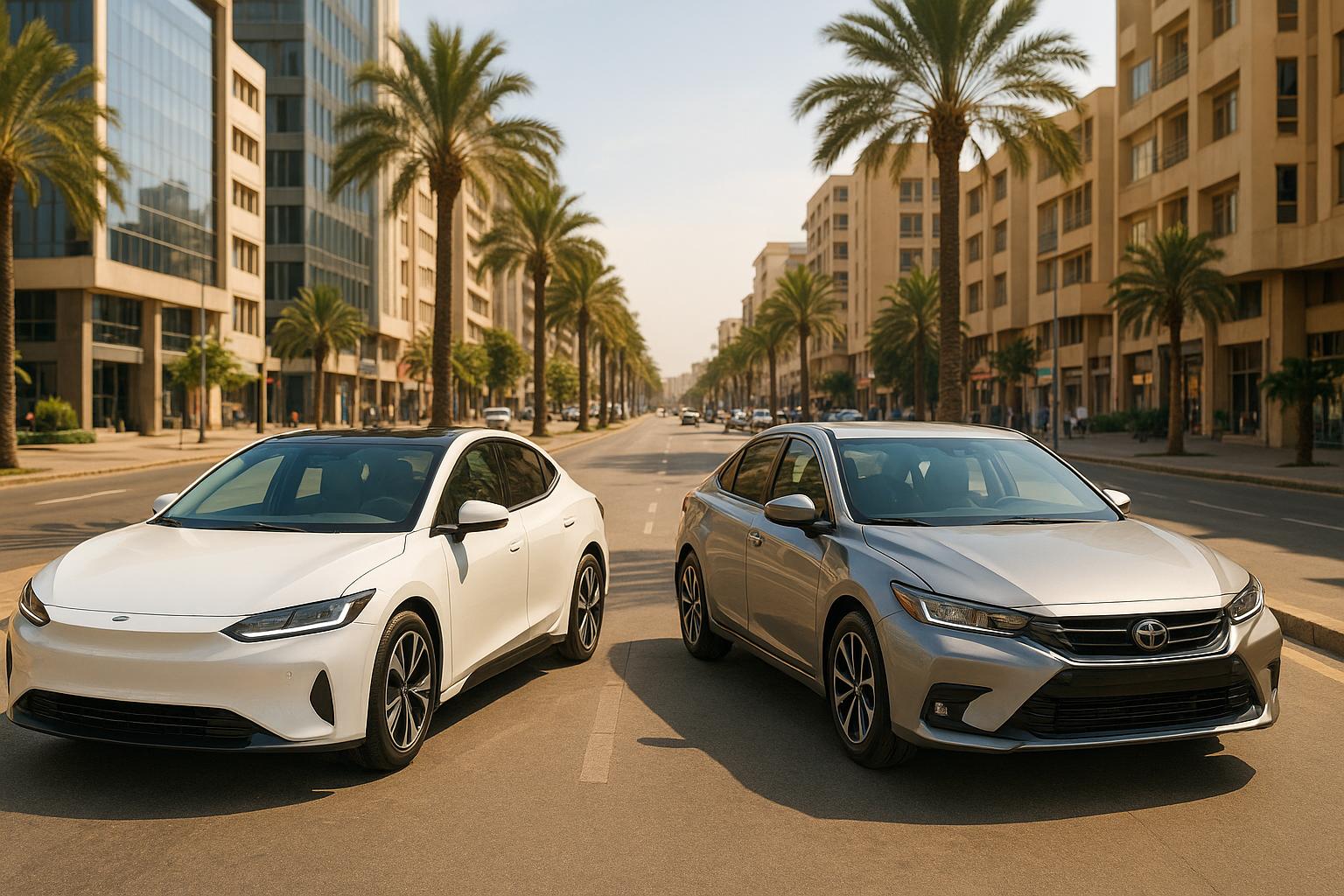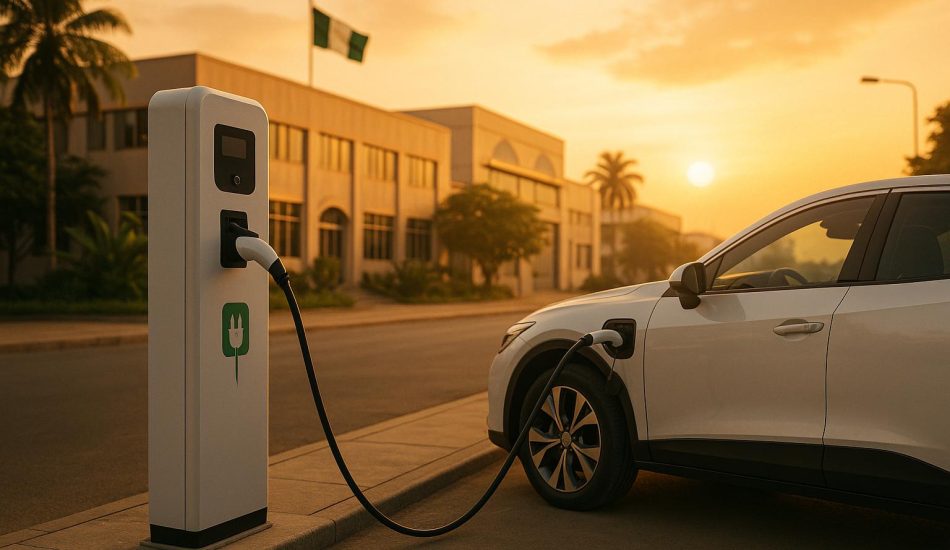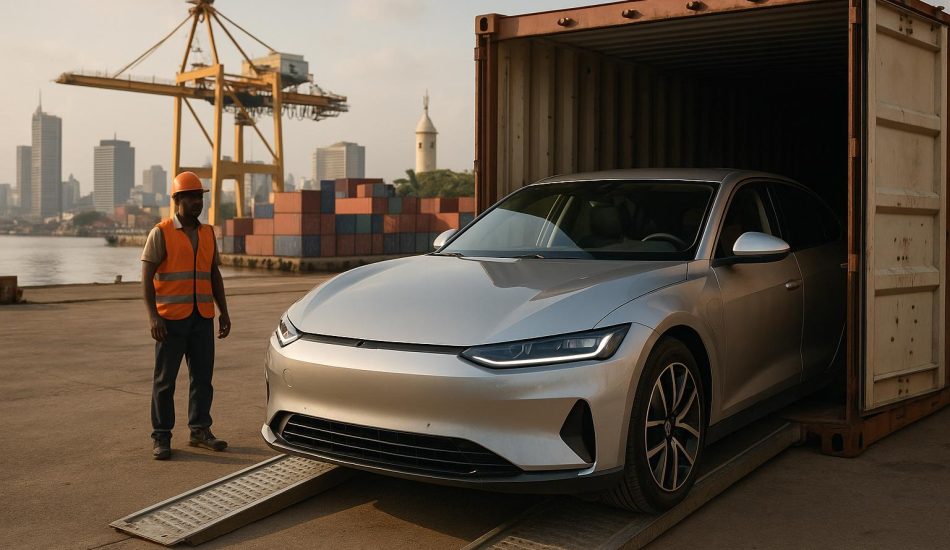
Battery Electric Vehicles (BEVs) and hybrids are competing for buyers in Africa, each offering distinct advantages based on cost, infrastructure, and driving needs. Here’s what you need to know:
- Cost: BEVs are more expensive upfront but save on fuel and maintenance over time. Hybrids have a lower initial price and rely on existing gas stations.
- Infrastructure: BEVs are ideal for cities with charging networks like Lagos and Nairobi, while hybrids suit rural areas with limited chargers.
- Climate: BEV batteries degrade faster in extreme heat, common in Africa, while hybrids are less affected.
- Environmental Impact: BEVs produce zero tailpipe emissions but depend on how clean the electricity grid is. Hybrids still emit CO2 but use less fuel overall.
Quick Comparison
| Factor | BEVs | Hybrids |
|---|---|---|
| Cost | Higher upfront cost | Lower upfront cost |
| Fuel/Charging | Requires electricity | Uses both gasoline and electricity |
| Range | Limited by charging stations | Gasoline ensures flexibility |
| Power Grid Dependency | Fully dependent | Partially dependent |
| Heat Performance | Battery degrades in high heat | Less affected by heat |
| Tailpipe Emissions | Zero | Reduced but not zero |
Hybrids currently dominate due to affordability and flexibility, but BEVs are gaining traction in cities with better charging options and renewable energy initiatives.
Hybrid vs Non-Hybrid Cars in Kenya / Africa Review : Complete Guide for First Time Car Buyers
Cost and Financing Options
The higher upfront price of battery electric vehicles (BEVs) remains a significant hurdle for many buyers in Africa. BEVs often come with a steeper price tag compared to hybrids, even though they promise savings on fuel and maintenance over time.
To address these cost challenges, flexible financing options are becoming more common. Take EV24.africa, for example – they offer payment plans designed to make electric vehicles more attainable. Additionally, innovative local payment systems are being created to align with regional income patterns. These evolving solutions are helping to break down financial barriers, making BEVs and hybrids more accessible to a larger audience across the continent.
Infrastructure and Regional Challenges
Beyond cost, infrastructure plays a major role in shaping vehicle choices for African buyers. The continent’s infrastructure varies widely, creating disparities in access between urban hubs and rural areas.
Cities like Lagos, Nairobi, and Cape Town are expanding their charging networks, making battery electric vehicles (BEVs) more viable in these areas. However, rural regions often lack such facilities, making hybrids a more practical option for those who frequently travel between cities or live in remote locations.
Hybrids offer a clear advantage in terms of infrastructure. They can switch seamlessly to gasoline when their electric range is depleted, leveraging the extensive network of gas stations already in place. Many hybrid models provide a limited electric range, ideal for daily commutes, while gasoline ensures reliability for longer trips.
Power grid reliability also plays a big role in vehicle selection. In areas with stable electricity, BEVs are more appealing, as they can be charged at home. However, frequent power outages in some regions make hybrids a more dependable choice.
Another hurdle for BEVs is charging speed. Long charging times – sometimes several hours – can make BEVs less convenient outside major cities, where fast-charging stations are scarce.
| Infrastructure Factor | Battery Electric Vehicles (BEVs) | Hybrid Vehicles |
|---|---|---|
| Charging/Fueling Availability | Limited to urban areas | Accessible via gas stations |
| Range Anxiety | Higher in areas with few chargers | Lower, thanks to gasoline |
| Infrastructure Investment | Requires new charging networks | Relies on existing gas stations |
| Power Grid Dependency | Fully dependent on electricity | Partially dependent |
| Maintenance Network | Needs specialized service centers | Can use traditional mechanics |
These factors significantly influence whether buyers lean toward BEVs or hybrids.
Regional approaches to infrastructure development also vary. Some East African countries are exploring solar-powered charging stations to harness renewable energy, while parts of West Africa are prioritizing urban charging hubs before expanding to less populated areas.
The cost of building new charging infrastructure directly impacts vehicle pricing and market accessibility. Buyers must weigh these factors, as vehicle prices often reflect the level of infrastructure investment required.
To address these challenges, innovative solutions are emerging. Mobile charging units and battery-swapping services are gradually filling coverage gaps, making BEVs more practical even in regions where traditional infrastructure is lacking. These advancements are reshaping the landscape, offering hope for broader BEV adoption in the future.
sbb-itb-99e19e3
Climate Impact and African Driving Conditions
When it comes to vehicle preferences in Africa, factors like climate and driving conditions play a crucial role alongside cost and infrastructure. Battery electric vehicles (BEVs) stand out for their ability to eliminate tailpipe emissions entirely, unlike hybrids, which still rely partly on gasoline engines that emit carbon dioxide and other pollutants.
However, the environmental impact of BEVs depends heavily on how electricity is generated in different regions. In countries like Morocco and South Africa, which are making strides in renewable energy, BEVs shine. Morocco’s Noor solar complex, for example, generates over 580 megawatts of clean energy, making BEVs a greener choice in such areas. On the flip side, regions that depend on coal or diesel for electricity reduce the environmental edge of BEVs. While charging a BEV in these areas still results in fewer emissions than driving a gasoline car, the benefits are less pronounced.
African climates also challenge battery performance. Lithium-ion batteries, which power both BEVs and hybrids, work best in temperatures between 68°F and 86°F. Many African regions, however, experience extreme heat, with temperatures soaring to 104°F or more. In such conditions, BEV batteries can lose 15-20% of their capacity and degrade faster, leading to reduced driving range and the need for earlier replacements. Hybrids, while not immune to these issues, are less affected since they rely less on their batteries.
Dust and humidity are also significant considerations. While both BEVs and hybrids need robust sealing and filtration systems to protect their sensitive electronics, BEVs have fewer moving parts, which might make them slightly more resistant to dust damage. Hybrids, with their combination of electric and combustion systems, are more complex and potentially more vulnerable.
Battery recycling infrastructure is another hurdle. While South Africa has started developing e-waste recycling programs, most African nations lack facilities to handle end-of-life EV batteries. Without proper disposal systems, the environmental risks, such as soil and water contamination, increase as EV adoption grows.
Driving habits in Africa often make hybrids a more practical choice. Long-distance travel between cities is common, and road conditions can be tough. Hybrids offer flexibility by switching to gasoline when the electric range is depleted, making them better suited for unpredictable terrains and extended journeys.
| Climate Factor | Battery Electric Vehicles (BEVs) | Hybrid Vehicles |
|---|---|---|
| Direct Emissions | Zero tailpipe emissions | Reduced but not eliminated |
| Grid Dependency | Varies by regional energy mix | Partially dependent on grid |
| High Temperature Performance | 15-20% capacity loss above 86°F | Less affected due to dual power |
| Battery Degradation | Faster in extreme heat | Slower due to less battery stress |
| Dust Resistance | Fewer moving parts to protect | More complex systems vulnerable |
| End-of-Life Impact | Recycling infrastructure limited | Traditional disposal options available |
| Range in Harsh Conditions | May be significantly reduced | Gasoline backup ensures reliability |
Seasonal changes also influence vehicle preferences. During rainy seasons, when roads become harder to navigate and power outages are frequent, hybrids are more reliable. Their ability to operate independently of the electrical grid makes them appealing in areas with inconsistent power supplies.
Meanwhile, solar integration is emerging as a promising solution for BEV owners in sunny parts of Africa. Some drivers are installing home solar systems to charge their vehicles, creating a cleaner and more self-sufficient transportation setup. This approach works particularly well for urban professionals with predictable commutes and adequate roof space for solar panels.
When comparing total lifecycle emissions, BEVs typically produce 50-70% fewer emissions than traditional gasoline vehicles. Hybrids fall in the middle, offering a 20-40% reduction in emissions. As more African countries expand their renewable energy capacity, the environmental benefits of BEVs will only grow stronger, paving the way for broader adoption in the future.
Conclusion
Deciding between battery electric vehicles (BEVs) and hybrid vehicles depends on factors like budget, local infrastructure, and driving habits. Let’s break down the key findings from our analysis.
Hybrids remain a practical choice for many buyers right now. They come with a lower upfront cost and the flexibility to rely on gasoline, which is especially useful in areas where power supply can be unpredictable. This makes hybrids a reliable option for a wide range of drivers.
That said, BEVs are starting to make waves in urban areas with more developed charging networks. Cities such as Cape Town, Lagos, and Nairobi are seeing a rise in BEV ownership, particularly among middle-class professionals who can afford the higher initial costs. With zero tailpipe emissions and lower running expenses, BEVs are becoming an appealing choice for daily commuters in these settings.
In places investing heavily in renewable energy, BEVs offer a cleaner, greener future. For example, Morocco’s large-scale solar projects are creating conditions where BEVs can genuinely reduce environmental impact. On the other hand, regions still relying on coal or diesel for electricity see fewer environmental benefits from going electric.
The lack of charging infrastructure remains the biggest challenge for widespread BEV adoption across Africa. While urban areas are slowly building charging networks, rural regions and long-distance routes still lag far behind.
Over time, as charging networks grow, BEV prices drop, and advances in battery technology make these vehicles better suited for hotter climates, the balance may shift. Government incentives will likely play a role in accelerating this change. For now, hybrids strike a middle ground, offering both eco-consciousness and practicality for most buyers. Looking ahead, Africa’s mobility landscape will likely feature both technologies, with the right choice depending on individual needs, location, and driving patterns.
FAQs
What factors are shaping African buyers’ preferences for battery electric vehicles (BEVs) versus hybrid vehicles in 2025?
In 2025, the preferences of African buyers for battery electric vehicles (BEVs) and hybrid vehicles are shaped by several important factors:
- Affordability: Price is a major consideration for many buyers. Hybrids are often viewed as a more cost-effective choice due to their lower initial cost compared to BEVs.
- Charging infrastructure: The availability of public charging stations plays a big role in BEV adoption. In regions where charging networks are sparse, BEVs face challenges.
- Environmental concerns: With growing awareness of climate change, a rising number of consumers are leaning toward vehicles with lower emissions, giving BEVs a notable appeal for their eco-friendliness.
Hybrids remain a popular option in areas where charging infrastructure is still developing. However, as charging networks improve and BEV prices become more competitive, BEVs are steadily gaining ground. The decision between the two often boils down to local conditions and individual priorities.
How does Africa’s hot climate affect the performance and lifespan of BEV and hybrid batteries?
Africa’s scorching temperatures can take a toll on battery electric vehicle (BEV) batteries, affecting both their performance and lifespan. High heat speeds up battery degradation, which means reduced efficiency and a shorter overall life. This is especially true for BEVs, as their larger battery packs are more susceptible to these effects.
On the other hand, hybrid vehicles come with smaller batteries that are generally better suited to handle temperature swings. This makes hybrids a sturdier option in hot climates, as their battery systems are less likely to overheat or wear out quickly. For those living in areas with consistently high temperatures, hybrids might be the more dependable choice in the long run.
What are some innovative ways Africa is addressing the challenge of limited EV charging infrastructure?
Africa is addressing the challenge of limited EV charging infrastructure with solutions designed specifically for its unique circumstances. One promising approach is battery swapping technology, which lets drivers exchange drained batteries for fully charged ones in a matter of minutes, cutting down on wait times. Another game-changing solution is the creation of off-grid solar-powered charging stations. These stations rely on renewable energy, making it possible to charge EVs in areas where access to reliable electricity is scarce. Together, these efforts are making electric vehicles a more viable option across the continent, even in hard-to-reach regions.




